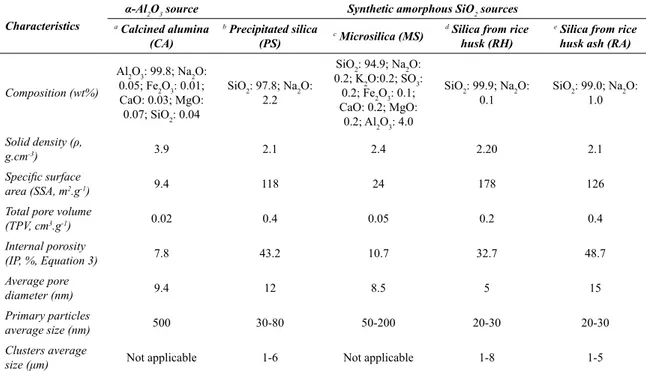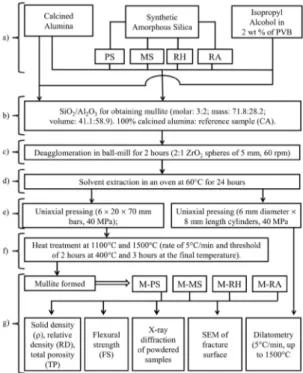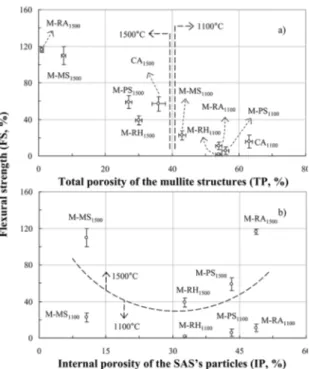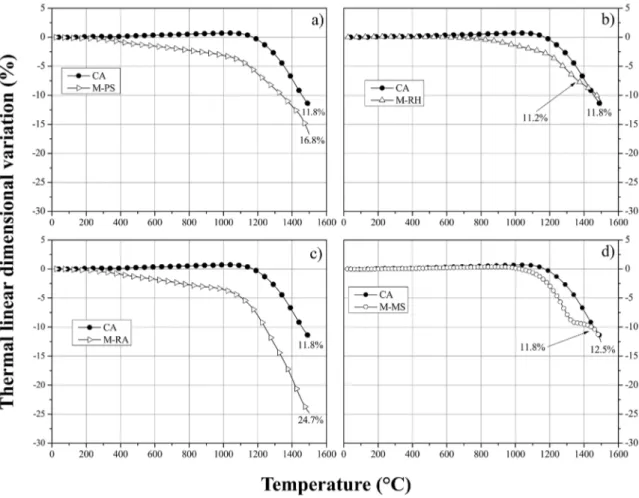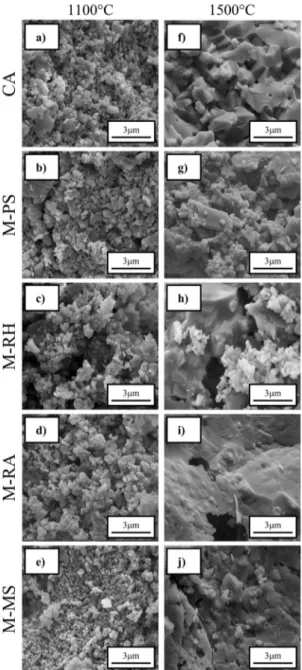Preparation and Characterization of Mullite-Alumina Structures Formed "In Situ" from
Calcined Alumina and Different Grades of Synthetic Amorphous Silica
Leandro Fernandesa , Rafael Salomãoa*
Received: August 30, 2017; Revised: January 29, 2018; Accepted: February 02, 2018
The in situ reaction between alumina and silica to obtain mullite (Al6Si4O13) can be significantly
affected by using synthetic amorphous silica (SAS) sources instead of crystalline ones (quartz and cristobalite). For instance, SASs promote early mullite formation (below 1300°C) and greater densification during sintering. This paper reports the "in situ" formation of mullite-alumina structures
from fine calcined alumina (α-Al2O3) and four grades of SAS of different particles' morphology,
specific surface area and internal porosity. After sintering assisted by dilatometry (up to 1500°C), the samples' total porosity, density and flexural strength were measured. The relative density and strength levels of some of these structures were greater than or comparable to other studies in which similar compositions were sintered at higher temperatures (1600-1700°C). Their microstructure assessment indicated that the specific surface area and internal porosity of SAS particles showed a major influence in the development of these physical properties.
Keywords: Synthetic amorphous silica, mullite, microstructure, physical properties, calcined
alumina, densification.
*e-mail: rsalomao@sc.usp.br
1. Introduction
Mullite (3Al2O3.2SiO2 or Al6Si2O13), one of the main
raw materials for the ceramic industry1- 4, is an input for the
production of refractory materials1,5-9, catalyst support10,11,
electronic and optic devices12-14, thermal insulators8,9,15, hot
gas filters (above 600°C)16-18 and biological and biomedical
scaffolds19-21. Its formation is a complex set of high-temperature
(800-1400°C) solid state reactions22-24 between silica (SiO
2)
and alumina (Al2O3)25- 29 based on the mutual diffusion
of Al3+, Si4+ and O-2 ions amongst particles30-33. Various
studies have pointed out the characteristics of the silica
source (crystallinity35, particle size distribution25, presence
of impurities26,27) and processing conditions (heating rate28,
temperature of the thermal treatment29) affect directly the
yield, kinetics and morphology of the products formed2,7-10. For
instance, reactions between coarse alumina and micronized quartz particles (45 µm average size) generate porous mullite at temperatures above 1300ºC9,28,31, whereas the combination
of finer nanoparticles of alumina and amorphous silica produced by alcoxi-based precursors reduced the range to 800-1100ºC and promote greater densification35-37. Therefore,
by changing the characteristics of the silica source, ceramics of different microstructures, porosity levels and
thermo-mechanical properties can be designed.
Amongst the several raw materials available for mullite production, many recent studies have explored the use of
synthetic amorphous silica (SAS) grades because they are
high-purity particles (SiO2-content above 97 %) of great
homogeneity and reproducibility. During the first heating
and above the glass transition temperature (typically in the
900-1100°C range), their viscous flow behaves as sintering aid enhancing particle densification. SASs particles can be produced in a wide range of characteristics, as shown
elsewhere38. Its technological importance suggests that it
is important to understand how these different physical properties could affect mullite formation. Therefore, in this study, four grades of SAS8,15,38,39 (Table 1, Fig. 1) were tested
regarding their ability in generating dense structures of in situ mullite after a reaction with fine calcined alumina. They
were chosen because they exhibit similar average particle sizes and purity and significant differences in other physical properties, such as a specific surface area and levels of
intra-particle mesoporosity.
Silica precipitated from sodium silicate (PS, Fig. 1a) is a commercial additive used as a reinforcing filler for paints, tires
and other polymeric composites38,39. Its particles are slightly
irregular in shape due to the milling and desagglomeration steps involved in their production. At the same time, its physical properties are highly reproducible, such as its
specific surface area (above 200 m2.g-1)39. Silica particles
extracted from rice husk (RH, Fig. 1c)39-44 and rice husk ash
(RA, Fig. 1d)45-47 also show specific surface areas above 200 m2.g-1 and morphology composed of aggregates of 100 nm
average size of primary particles of 20 to 30 nm 47.In both
cases, besides the low-costs, the presence of a large amount aDepartamento de Engenharia de Materiais, Escola de Engenharia de São Carlos, Universidade de São
Table 1. Characteristics of the raw materials tested.
Characteristics
α-Al2O3 source Synthetic amorphous SiO2 sources a Calcined alumina
(CA)
b Precipitated silica
(PS) c Microsilica (MS)
d Silica from rice
husk (RH)
e Silica from rice
husk ash (RA)
Composition (wt%)
Al2O3: 99.8; Na2O:
0.05; Fe2O3: 0.01; CaO: 0.03; MgO:
0.07; SiO2: 0.04
SiO2: 97.8; Na2O:
2.2
SiO2: 94.9; Na2O: 0.2; K2O:0.2; SO3:
0.2; Fe2O3: 0.1; CaO: 0.2; MgO:
0.2; Al2O3: 4.0
SiO2: 99.9; Na2O:
0.1
SiO2: 99.0; Na2O:
1.0
Solid density (ρ,
g.cm-3) 3.9 2.1 2.4 2.20 2.1
Specific surface
area (SSA, m2.g-1) 9.4 118 24 178 126
Total pore volume
(TPV, cm3.g-1) 0.02 0.4 0.05 0.2 0.4
Internal porosity
(IP, %, Equation 3) 7.8 43.2 10.7 32.7 48.7
Average pore
diameter (nm) 9.4 12 8.5 5 15
Primary particles
average size (nm) 500 30-80 50-200 20-30 20-30
Clusters average
size (μm) Not applicable 1-6 Not applicable 1-8 1-5
a) A1000SG, Almatis, Germany; b) Tioxil T300, Solvay-Rhodia Group S/A, Brazil; c) Microsilica 971, Elkem, Norway; d) References 40,43; e) Reference 45.
Figure 1. SEM images of the synthetic amorphous silica (SAS)
grades tested: a) silica precipitated from sodium silicate (PS), b) silica obtained from rice husks (RH), c) silica obtained from rice
husk ashes (RA), d) microsilica (MS)
of intra-particle mesoporosity suggests that these silica grades can be extremely reactive in contact with calcined
alumina at high temperatures. Microsilica (MS, Fig. 1d)
particles are spherical, dense and individualized and their broad particle size distribution ranges from 50 to 500 nm. They are obtained as a precipitated by-product during the production of elemental silicon and are widely used in civil construction for enhancing the packing of high performance
concrete, and in refractories for the production of
mullite-based bricks and castables1,7,8,15,38,39,48,49.
After physical characterization, the SAS particles
were combined with calcined alumina to produce in situ
mullite dense parts. Their sintering behavior was assisted
by dilatometry and the products formed were identified by X-ray diffraction and scanning electron microscopy. The
physical properties (solid and relative density, total porosity,
flexural strength) of the resulting structures were related to the characteristics of the amorphous silica particles.
2. Materials and Methods
2.1. Synthesis and characterization of the
particles
The following raw materials (Table 1) were used: a) calcined alumina (CA, A1000SG, Almatis, Germany), b) silica from the precipitation of sodium silicate (PS, Tixosil T300, Solvay-Rhodia Group S/A, Brazil), c) silica extracted from rice husk (RH43), d) silica extracted from rice husk ash
(RA43), e) silica obtained by the precipitation of oxidized
silicon vapor (MS, Microsilica 971, Elkem, Norway), f) organic binder (PVB; Poly(vinyl butyral), Butivar 98, Sigma-Aldrich, USA) and g) isopropyl alcohol (Synth, Brazil).
The RH particles40,43 were produced initially washing
dried rice husks with a 10 wt% citric acid solution (C6H8O7;
Brazil) for 1 h at 127°C ± 5°C and 150 kPa ± 20 kPa. After neutralization with distilled water and drying (100°C ± 5°C for 12 h), the husks were calcined at 700°C for 2 hours at 15ºC/min heating rate. The calcined material was dry-milled for 2 hours (ball-mill operating at 60 rpm with ZrO2 spheres
of 5 mm diameter; spheres ratio of 10:1 in relation to the
dried material).
To obtain RA particles45, a suspension containing 0.1 wt%
of rice husk ash in a 2 Mol.L-1 sodium hydroxide (NaOH)
solution was heated under reflux conditions for 2 h. The sodium silicate solution formed was filtered to remove the non-reacted ashes, and hydrochloric acid (HCl, 2 mol.L-1)
was added until pH = 3 for the formation of a gel of silica particles, according to Equation 1:
(1)
RA particles were attained after intensive washing with distilled water for the removal of sodium chloride salt, filtering and drying (2 h at 110°C).
Particles samples were previously degassed at 200°C for 3 h in a vacuum atmosphere and then characterized regarding the specific surface area (SSA, m2.g-1, BET method, ASTM C
1069-09 standard "Standard Test Method for Specific Surface Area of Alumina or Quartz by Nitrogen Adsorption"), total pore volume (TPV, cm3.g-1, for pores thinner than 50 nm)
and average pore diameter (PD), by adsorption-desorption isotherms of high-purity N2 (Nova 1200e, Quantachrome
Instruments, USA; the ratio between relative pressure, P, and atmospheric pressure, P0, ranged from 0.05 up to 1). Their
density (ρ, g.cm-3) was measured by the Helium picnometer
method (Ultrapyc 1200e, Quantachrome Instruments, USA). The particles' internal porosity (IP, %) is the ratio between the total pore volume inside the particles (TPV) and the total volume of the particles (which corresponds to the sum of TPV
and solid volume)39. The IP was calculated by Equation 2:
(2)
2.2. Preparation and characterization of mullite
samples
The stoichiometric composition of mullite (3Al2O3.2SiO2.)
22-24
was prepared combining the different silica grades (PS, MS, RH and RA) and calcined alumina (CA) (Fig. 2a-b). The deagglomeration and mixing processes of alumina and silica particles were performed in a ball-mill with a 2 wt% of PVB isopropyl alcohol suspension containing 33% solids (grinding specification: 5 mm diameter zirconia spheres, mass ratio of sphere/powder: 1:3, 2 liters polyethylene flask, 60 rpm for 2 hours; Fig. 2c). The isopropyl alcohol was completely
evaporated (Fig. 2d) and the resulting powder was shaped
by uniaxial compression (40 MPa, Fig. 2e). The sintering of
green samples (8 mm length × 6 mm diameter cylinders) was
monitored by a 402C dilatometer (NETZSCH, Germany), under a 5°C/min heating rate up to 1500°C.
Samples for porosity and mechanical property measurements (bars of 6 × 20 × 70 mm) were heat-treated at 1100°C and 1500°C (heating rate of 5°C/min, threshold of 2 hours at 400°C and 3 h at the final temperature, 10ºC.min-1 cooling
rate) (Fig. 2f-g). Their relative density (RD, %) and the total porosity (TP, %) 15,50 were calculated using Equations 3 and 4
(3)
(4)
M, L, W and T are, respectively, the samples' mass (g)
and average length (cm), width (cm) and thickness (cm).
The density of these materials (ρ) was measured by the Helium picnometer method in equivalent samples after
milling (DPart ≤ 100 µm). Na SiO2 3+2HCl"SiO2(Precipitated)+2NaCl(Dissolved)
(%)
%
(
)
(
)
IP
TPV
TPV
100
#
#
1
#
t
t
=
#
+
&
(%)
%
RD
=
100
#
T
M
L
#
W
#
T
#
t
Y
(%)
TP
=
100
-
RD
Figure 2. Experimental procedure for the preparation and characterization
of in situ mullite-alumina samples
A universal testing machine (WDW-30E, China, 0.5
mm.min-1 load application rate) and Equation 5 were used
to determine their flexural strength (FS, MPa) by the Three-Point Bending Test (ASTM C78: "Standard Test Method for Flexural Strength of Concrete Using Simple Beam with Third-Point Loading"):
(5)
(
)
(
)
(
)
FS MPa
F
S
W
T
3
2
2#
#
#
#
F is the maximum applied load (N), S is the distance between the two supporting points (m), and W (m) and T (m) are the average width and thickness of the test sample, respectively. In all cases, five samples were tested for each
condition.
The results attained were compared with other similar
systems using relative flexural strength (RFS, %) versus
relative density (RD, %) curves15. RFS is the ratio between
the experimental results of FS and the theoretical value obtained for a 100% dense sample (for mullite 2-4,16,30,34,51,
FSTheoretical = 180 MPa). Such an approach is useful for
investigating the mechanical behavior of porous (RD ≤ 50 %) and semi-porous structures (95% ≤ RD > 50 %). It is based on the fact that, ideally, a reduction in the material's relative density (caused by the introduction of new internal surfaces, as pores) would be followed by a proportional reduction of its mechanical properties. Such a behavior is represented by the y = x function. In real cases, however, most commonly, the reduction of the mechanical properties caused by the introduction of porosity is far more intense due to the presence of tensile concentrators and lack of efficient
sintering amongst particles15,50.
The phases formed during thermal treatment were identified by X-ray diffraction (Rigaku, Rotaflex RV 200B, Japan, pulverized samples). The microstructure of the samples was assessed at fracture surfaces by field emission gun scanning electron microscopy (SEM, FEI, Inspect F50
model, Netherlands).
3. Results and Discussion
3.1 Samples sintered at 1100ºC
Samples containing precipitated silica (M-PS1100), silica
from rice husk (M-RH1100) and silica from rice husk ash
(M-RA1100) showed lower total porosity and flexural strength
levels (Fig. 3a) and earlier densification (Fig. 4a-c) than the silica-free reference sample (CA1100). Such behavior can be
explained analyzing the same flexural strength results as a function of silica particles' internal porosity (IP) (Fig. 3b and Table 1). The particles of these three SAS grades are comprised of nanoclusters strongly aggregated containing large quantity of mesopores amongst them (Fig. 1). These pores are smaller than 30 nm and are extremely unstable
under heating. Due to this, even mild temperatures, such as
400-800ºC can induce their collapse and early densification of the silica particles39,45. The overall effect upon the samples'
structure is an intense macroscopic shrinkage and porosity
reduction, not necessarily followed by gains of strength. For microsilica-containing samples (M-MS1100), on the
other hand, a different behavior was observed. Comparing
Figure 3. Flexural strength of samples containing different synthetic
amorphous silica (SAS) grades thermally treated at 1100ºC and 1500ºC as a function of a) total porosity of the structures obtained after sintering and b) SAS particles' internal porosity (IP). The dotted lines are guides to indicate the temperatures of thermal treatment
to the other SAS grades, MS particles have a much lower
internal mesoporosity (IP = 10.7 %) and specific surface area. Due to this, its reduces the amount of voids amongst particles
at the compacting step1,6,8,48. During the initial heating, no
significant densification was observed up to 1000ºC (Fig. 4d). After sintering at 1100ºC, M-MS samples exhibited the lowest level of porosity and the highest flexural strength amongst the silica-containing-ones. It is also possible that the impurities of the microsilica have generated some small portion of low melting point the liquid phase. They were not detected after cooling in this study but such effect has
been already described elsewhere.
No traces of silica crystallization or mullite formation
were detected by XRD (Fig. 6) in the samples sintered at
1100ºC. Their fracture surfaces (Fig. 5a-e) are comprised of porous granular packs of individualized particles containing
very low necking points. These two aspects indicate that only physical rearrangements, such as pore coalescence
or viscous flow8,32,49, occurred up to 1100ºC and that the
physical properties of the structures were defined mainly by the calcined alumina matrix behavior.
3.2 Samples sintered at 1500ºC
Figure 4. Thermal linear variation for samples containing different synthetic amorphous silica (SAS) grades: a) M-PS, b) M-RH, c)
M-RA, d) M-MS
thermally treated at 1100ºC (Fig. 3a). Their microstructure (Fig. 5f-j) evolved to a solid block comprised of mullite (major constituent) and traces of un-reacted corindon and cristobalite (Fig. 6), where evidence of viscous flow can be seen. The dilatometric analysis of the M-PS1500, M-RH1500 and M-RA1500 samples (Fig. 4a-c) revealed total shrinkage levels similar or greater than the one observed for the silica-free reference (CA1500). For such compositions, the larger
the IP of the silica particles, the more intense the reduction in the structures' total porosity and enhancement of their
strength (Fig. 3b).
The densification rate of the M-MS sample was significantly reduced between 1300-1430ºC (Fig. 4d). This
behavior was also observed in other studies8,9,15 and can be related to the mullite generation reaction. In comparison to
the calcined alumina matrix (ρ = 3.8-4 g.cm-3), the density
of mullite is lower (ρ = 3.2 g.cm-3), therefore, its formation
can be followed by a volumetric expansion, depending on the compacting level of the structure. In the present case, since MS improved the initial structure packing efficiency,
the formation of mullite partially hindered the particles' densification. However, due to the presence of several
alkali-based impurities in the MS composition, it is reasonable to
assume the high flexural strength attained is also related to a certain level of liquid sintering.
The comparison between the RFS values of this study
to those in other reports (Fig. 7) has shown two important
aspects. Firstly, for the range of relative density of 45-99 %
tested, the RFS showed a linear variation, which indicates it is possible to tailor such property level depending on the
application. For instance, compositions of higher RFS and low porosity, such as M-RA1500 and M-MS1500, could be
used to produce refractory bricks or abrasive tools. On the other hand, those of lower RD (M-RH1100 and M-PS1100)
could be used as porous structures for thermal insulation or as biological scaffolds. Secondly, the overall level of the
RFS values obtained in this work is close to those described
in the literature for samples of similar compositions, but produced by more complex compaction techniques (isostatic
Figure 5. Fracture surfaces of samples treated at 1100ºC and 1500ºC
for 3 h (SEM observation)
Figure 6. X-ray diffraction patterns for samples treated at 1100ºC
and 1500ºC for 3 h: a) M-PS, b) M-RH, c) M-RA, d) M-MS. Crystalline phases (JCPDS file): C = corundum (α-Al2O3, 42-1468), S = cristobalite (SiO2, 39-1425), M = mullite (Al6Si4O13, 15-0776)
Figure 7. Relative flexural strength (RFS) versus relative density
(RD) for samples tested (other results from the literature are also
shown on the same basis)
higher thermal treatment temperatures (above 1500°C28,29)
or with the aid of liquid phase sintering27,32. Therefore, for
similar levels of flexural strength, a significant energy saving
4. Conclusions
The internal porosity and specific surface area of the synthetic amorphous silica (SAS) particles tested significantly impacted the development of microstructure and physical properties of the alumina-mullite structures attained. Two opposite effects were observed.
Firstly, samples containing SAS grades of high internal porosity (silica precipitated from sodium silicate, silica obtained from rice husk, and silica obtained from rice husk ashes) experienced a significant shrinkage between 400-800ºC. At this temperature range, the mesopores located inside the particles of silica collapsed increasing their density and the overall packing efficiency of the system. As a consequence, after sintering at 1500ºC, structures of very low total porosity and high flexural strength were attained.
The comparison with other reports in literature showed that the strength levels attained were similar to other systems
sintered at higher temperatures for longer periods. This aspect
is technologically important because these compositions could
replace conventional materials and produce a significant energy saving during the thermal treatment. Secondly, for samples containing the silica grade of very low internal porosity and specific surface area (microsilica), the spherical shape of such particles improved packing efficiency during the pressing
step. Due to this, comparing to the other SAS grades, the
microsilica-containing structures presented lower porosity and higher strength after sintering at 1100ºC. Besides this, such samples also showed lower densification rate and total linear shrinkage. This effect was attributed to the formation of mullite, which is can be an expansive reaction, when it
occurs in a dense structure.
After sintering at 1500ºC, all the samples exhibited a dense microstructure containing signals of viscous flow and were comprised mainly of mullite and small portions of un-reacted corindon (α-Al2O3). It is possible that the
crystallization of the SAS particles may have hindered the total conversion of the reactants in mullite or would require
longer thermal treatment periods. These aspects are currently
under investigation in authors' research group.
5. Acknowledgements
Authors acknowledge the Brazilian Research Foundations FAPESP (2010/19274-5) and CNPq (308762/2014-2, 455861/2014-5, 870346/1997-0) for supporting this work, and Solvay-Rhodia Group S/A (Brazil), Almatis (Brazil, USA and Germany) and Elkem (Norway) for supplying samples of raw materials. They are also indebted to Prof. Dr. J.M.D. Rollo, P.L. di Lorenzo and J.J. Bernardi (SMM/ EESC) for assistance in dilatometry and mechanical tests and Wagner R. Correr, MSc. (Microscopy Laboratory, CTMH SMM-EESC/IFSC) for SEM images.
6. References
1. Nishikawa A. Technology of Monolithic Refractories. Tokyo:
Plibrico Japan Co. Ltd; 1984.
2. Anggono J. Mullite Ceramics: Its Properties, Structure, and
Synthesis. Jurnal Teknik Mesin. 2005;7(1):1-10.
3. Schneider H, Schreuer J, Hildmann B. Structure and properties of mullite-A review. Journal of the European Ceramic Society.
2008;28(2):329-344.
4. Schneider H, Fischer RX, Schreuer J. Mullite: Crystal Structure
and Related Properties. Journal of the American Ceramic
Society. 2015;98(10):2948-2967.
5. Dokko PC, Pask JA, Mazdiyasni KS. High-Temperature
Mechanical Properties of Mullite Under Compression. Journal
of the American Ceramic Society. 1977;60(3-4):150-155. 6. Ismael MR, Salomão R, Pandolfelli VC. Refractory Castables
Based on Colloidal Silica and Hydratable Alumina. American
Ceramic Society Bulletin. 2007;86(9):58-62.
7. Salomão R, Souza ADM, Fernandes L, Arruda CC. Advances in nanotechnology for refractories: When very small meets
hot, heavy, and large. American Ceramic Society Bulletin.
2013;92(7):22-27.
8. Sousa LL, Souza ADV, Fernandes L, Arantes VL, Salomão R. Development of densification-resistant castable porous structures from in situ mullite. Ceramics International.
2015;41(8):9443-9454.
9. Sousa LL, Salomão R, Arantes VL. Development and characterization of porous moldable refractory structures of
the alumina-mullite-quartz system. Ceramics International.
2017;43(1 Pt B):1362-1370.
10. Hamano K, Sato T, Nakagawa Z. Properties of Mullite Prepared by Co-Precipitation and Microstructure of Fired Bodies. Journal
of the Ceramic Association. 1986;94(1092):818-822. 11. Montanaro L, Tulliani JM, Perrot C, Negro A. Sintering of
industrial mullites. Journal of the European Ceramic Society.
1997;17(14):1715-1723.
12. Prochazka S, Klug FJ. Infrared-transparent mullite ceramic.
Journal of the American Ceramic Society. 1983;66(12):874-880. 13. Aksay IA, Dabbs DM, Sarikaya M. Mullite for Structural,
Electronic, and Optical Applications. Journal of the American
Ceramic Society. 1991;74(10):2343-2358.
14. Zhang L, Olhero S, Ferreira JMF. Thermo-mechanical and high-temperature dielectric properties of cordierite-mullite-alumina
ceramics. Ceramics International. 2016;42(15):16897-16905.
15. Salomão R, Fernandes L. Porous co-continuous mullite structures obtained from sintered aluminum hydroxide and synthetic
amorphous silica. Journal of the European Ceramic Society.
2017;37(8):2849-2856.
16. She JH, Ohji T. Fabrication and characterization of highly
porous mullite ceramics. Materials Chemistry and Physics.
2003;80(3):610-614.
17. Fukushima M, Yoshizawa YI. Fabrication and morphology control of highly porous mullite thermal insulators prepared
by gelation freezing route. Journal of the European Ceramic
18. Arzani M, Mahdavi HR, Bakhtiari O, Mohammadi T. Preparation of mullite ceramic microfilter membranes using Response surface
methodology based on central composite design. Ceramics International. 2016;42(7):8155-8164.
19. Nath S, Dey A, Mukhopadhyay AK, Basu B. Nanoindentation response of novel hydroxyapatite-mullite composites. Materials Science and Engineering: A. 2009;513-514:197-201.
20. Nath S, Basu B, Mohanty M, Mohanan PV. In vivo response of novel calcium phosphate-mullite composites: Results up to
12 weeks of implantation. Journal of Biomedical Materials
Research - Part B Applied Biomaterials. 2009;90B(2):547-557.
21. Nath S, Dubey AK, Basu B. Mechanical properties of novel calcium phosphate-mullite biocomposites. Journal of Biomaterials
Applications. 2012;27(1):67-78.
22. Davis RF, Pask JA. Diffusion and Reaction Studies in the
System Al2O3-SiO2. Journal of the American Ceramic Society.
1972;55(10):525-531.
23. Risbud SH, Pask JA. Mullite Crystallization from SiO2-Al2O3
Melts. Journal of the American Ceramic Society.
1978;61(1-2):63-67.
24. Aksaf LA, Pask JA. Stable and Metastable Equilibria in the
System SiO2-Al2O3. Journal of the American Ceramic Society.
1975;58(11-12):507-512.
25. Farenholtz WG, Smith DM, Cesarano J III. Effect of Precursor Particle Size on the Densification and Crystallization Behavior
of Mullite. Journal of the American Ceramic Society.
1993;76(2):433-437.
26. Pask JA. Importance of starting materials on reaction and phase equilibria in the Al2O3-SiO2 system. Journal of the European
Ceramic Society. 1996;16(2):101-108.
27. Chen CY, Lan GS, Tuan WH. Preparation of mullite by the
reaction sintering of kaolinite and alumina. Journal of the
European Ceramic Society. 2000;20(14-15):2519-2525.
28. Kara F, Little JA. Sintering behaviour of precursor mullite
powders and resultant microstructures. Journal of the European
Ceramic Society. 1996;16(6):627-635.
29. Yang F, Li C, Lin Y, Wang CA. Effects of sintering temperature
on properties of porous mullite/corundum ceramics. Materials
Letters. 2012;73:36-39.
30. Kanzaki S, Tabata H, Kumazawa T, Ohta S. Sintering and
Mechanical Properties of Stoichiometric Mullite. Journal of
the American Ceramic Society. 1985;68(1):C6-C7.
31. Saruhan B, Albers W, Schneider H, Kaysser WA. Reaction and sintering mechanisms of mullite in the systems
cristobalite/α-Al2O3 and amorphous SiO2/-Al2O3. Journal of the European
Ceramic Society. 1996;16(10):1075-1081.
32. Rani DA, Jayaseelan DD, Gnanam FD. Densification behaviour and microstructure of gel-derived phase-pure mullite in the presence of sinter additives. Journal of the European Ceramic
Society. 2001;21(12):2253-2257.
33. Fielitz P, Borchardt G, Schneider H, Schmücker M, Wiedenbeck
M, Rhede D. Self-diffusion of oxygen in mullite. Journal of
the European Ceramic Society. 2001;21(14):2577-2582.
34. Ismail MGMU, Nakai Z, Somiya S. Microstructure and Mechanical Properties of Mullite Prepared by the Sol-Gel Method. Journal
of the American Ceramic Society. 1987;70(1):C7-C8. 35. Bartsch M, Saruhan B, Schmücker M, Schneider H. Novel
Low-Temperature Processing Route of Dense Mullite Ceramics
by Reaction Sintering of Amorphous SiO2-Coated γ- Al2O3
Particle Nanocomposites. Journal of the American Ceramic
Society. 1999;82(6):1388-1392.
36. Cividanes LS, Campos TMB, Rodrigues LA, Brunelli DD, Thim GP. Review of mullite synthesis routes by sol-gel method.
Journal of the Sol-Gel Science and Technology. 2010;55(1):111-125.
37. Buljan I, Kosanovic C, Kralj D. A novel synthesis of nano-sized mullite from aluminosilicate precursors. Journal of Alloys and
Compouds. 2011;509(32):8256-8261.
38. Iler RK. The Chemistry of Silica: Solubility, Polymerization,
Colloid and Surface Properties and Biochemistry. New York:
Wiley; 1979.
39. Fernandes L, Arruda CC, Souza ADV, Salomão R. Characterization of Synthetic Amorphous Silica (SAS) Used in the Ceramic
Industry. Interceram. 2014;63(4):220-224.
40. Real C, Alcalá MD, Criado JM. Preparation of Silica from
Rice Husks. Journal of the American Ceramic Society.
1996;79(8):2012-2016.
41. Yalçin N, Sevinç V. Studies on silica obtained from rice husk.
Ceramics International. 2001;27(2):219-224.
42. Chandrasekhar S, Satyanarayana KG, Pramada PN, Raghavan P, Gupta TN. Review Processing, properties and applications of reactive silica from rice husk-an overview. Journal of Materials
Science. 2003;38(15):3159-3168.
43. Fernandes L, Sabino MG, Rosseto HL. Method of extration of silica from rice hull. Cerâmica. 2014;60(353):160-163.
44. Kaviyarasu K, Manikandan E, Kennedy J, Jayachandran M, Maaza M. Rice husks as a sustainable source of high quality nanostructured silica for high performance Li-ion battery
requital by sol-gel method - A Review. Advanced Materials
Letters. 2016;7:122-134.
45. Shelke VR, Bhagade SS, Mandavgane SA. Mesoporous Silica from Rice Husk Ash. Bulletin of Chemical Reaction Engineering
& Catalysis. 2010;5(2):63-67.
46. Ma X, Zhou B, Gao W, Qu Y, Wang L, Wang Z, et al. A recyclable method for production of pure silica from rice hull
ash. Powder Technology. 2012;217:497-501.
47. Cheah WK, Ooi CH, Yeoh FY. Rice husk and rice husk ash reutilization into nanoporous materials for adsorptive biomedical
applications: A review. Mesoporous Biomaterials.
2016;3(1):27-38.
48. Salomão R, Pandolfelli VC. Microsilica Addition as an Antihydration Technique for Magnesia-Containing Refractory Castables. American Ceramic Society Bulletin.
2007;86(6):9301-9309.
49. Khattab RM, El-Rafei AM, Zawrah MF. In situ formation of sintered cordierite-mullite nano-micro composites by utilizing of waste silica fume. Materials Research Bulletin.
50. Souza ADV, Sousa LL, Fernandes L, Cardoso PHL, Salomao
R. Al2O3-Al(OH)3-Based castable porous structures. Journal
of the European Ceramic Society. 2015;35(6):1943-1954.
51. Mah TI, Mazdiyasni KS. Mechanical properties of mullite.
